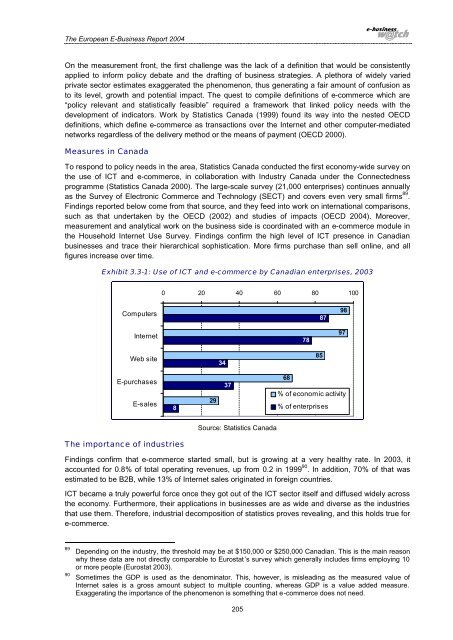The European e-Business Report 2004 - Berlecon Research GmbH
The European e-Business Report 2004 - Berlecon Research GmbH
The European e-Business Report 2004 - Berlecon Research GmbH
You also want an ePaper? Increase the reach of your titles
YUMPU automatically turns print PDFs into web optimized ePapers that Google loves.
<strong>The</strong> <strong>European</strong> E-<strong>Business</strong> <strong>Report</strong> <strong>2004</strong>On the measurement front, the first challenge was the lack of a definition that would be consistentlyapplied to inform policy debate and the drafting of business strategies. A plethora of widely variedprivate sector estimates exaggerated the phenomenon, thus generating a fair amount of confusion asto its level, growth and potential impact. <strong>The</strong> quest to compile definitions of e-commerce which are“policy relevant and statistically feasible” required a framework that linked policy needs with thedevelopment of indicators. Work by Statistics Canada (1999) found its way into the nested OECDdefinitions, which define e-commerce as transactions over the Internet and other computer-mediatednetworks regardless of the delivery method or the means of payment (OECD 2000).Measures in CanadaTo respond to policy needs in the area, Statistics Canada conducted the first economy-wide survey onthe use of ICT and e-commerce, in collaboration with Industry Canada under the Connectednessprogramme (Statistics Canada 2000). <strong>The</strong> large-scale survey (21,000 enterprises) continues annuallyas the Survey of Electronic Commerce and Technology (SECT) and covers even very small firms 89 .Findings reported below come from that source, and they feed into work on international comparisons,such as that undertaken by the OECD (2002) and studies of impacts (OECD <strong>2004</strong>). Moreover,measurement and analytical work on the business side is coordinated with an e-commerce module inthe Household Internet Use Survey. Findings confirm the high level of ICT presence in Canadianbusinesses and trace their hierarchical sophistication. More firms purchase than sell online, and allfigures increase over time.Exhibit 3.3-1: Use of ICT and e-commerce by Canadian enterprises, 20030 20 40 60 80 100Computers8798Internet7897Web site3485E-purchasesE-sales8293768% of economic activity% of enterprisesSource: Statistics Canada<strong>The</strong> importance of industriesFindings confirm that e-commerce started small, but is growing at a very healthy rate. In 2003, itaccounted for 0.8% of total operating revenues, up from 0.2 in 1999 90 . In addition, 70% of that wasestimated to be B2B, while 13% of Internet sales originated in foreign countries.ICT became a truly powerful force once they got out of the ICT sector itself and diffused widely acrossthe economy. Furthermore, their applications in businesses are as wide and diverse as the industriesthat use them. <strong>The</strong>refore, industrial decomposition of statistics proves revealing, and this holds true fore-commerce.8990Depending on the industry, the threshold may be at $150,000 or $250,000 Canadian. This is the main reasonwhy these data are not directly comparable to Eurostat’s survey which generally includes firms employing 10or more people (Eurostat 2003).Sometimes the GDP is used as the denominator. This, however, is misleading as the measured value ofInternet sales is a gross amount subject to multiple counting, whereas GDP is a value added measure.Exaggerating the importance of the phenomenon is something that e-commerce does not need.205
















